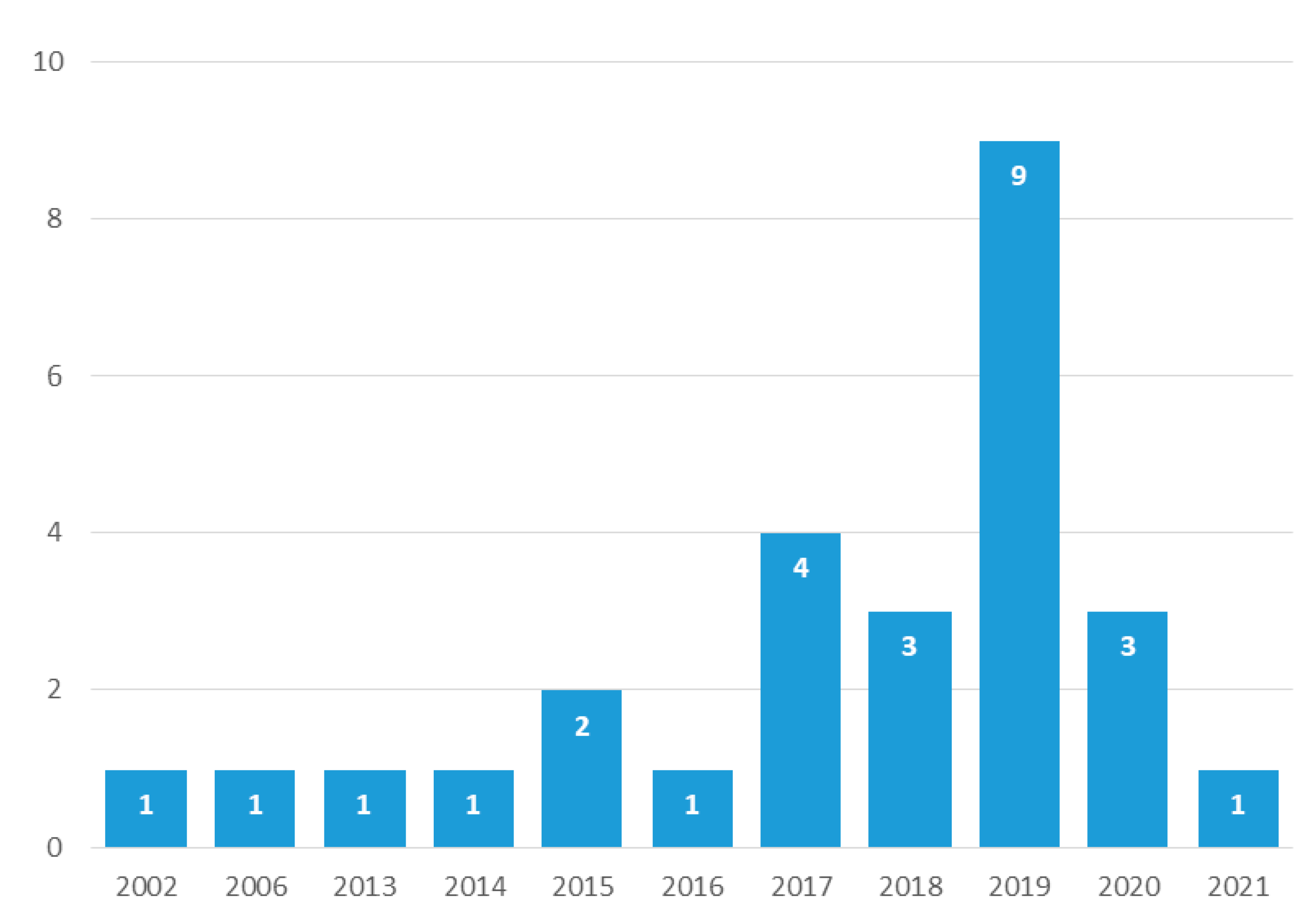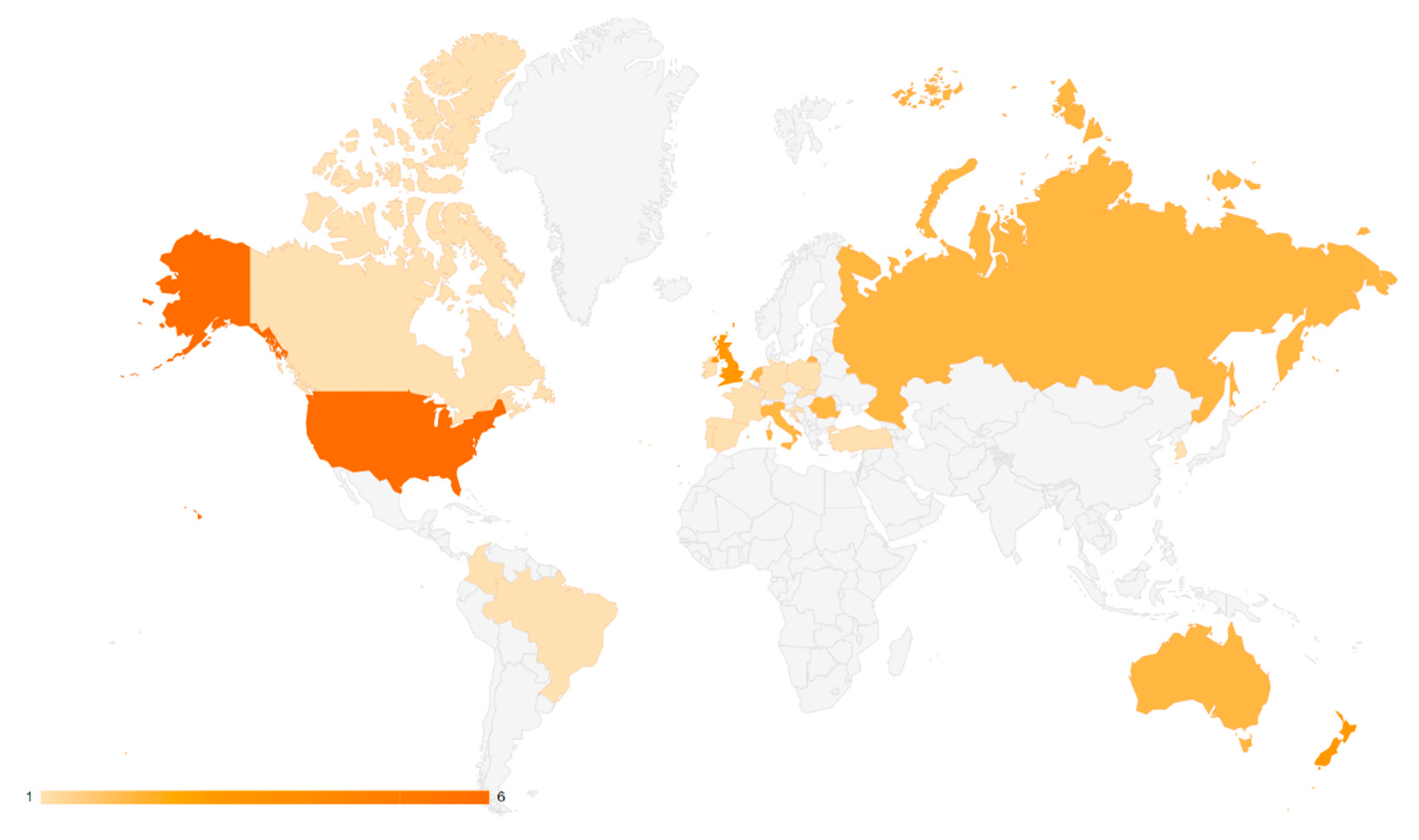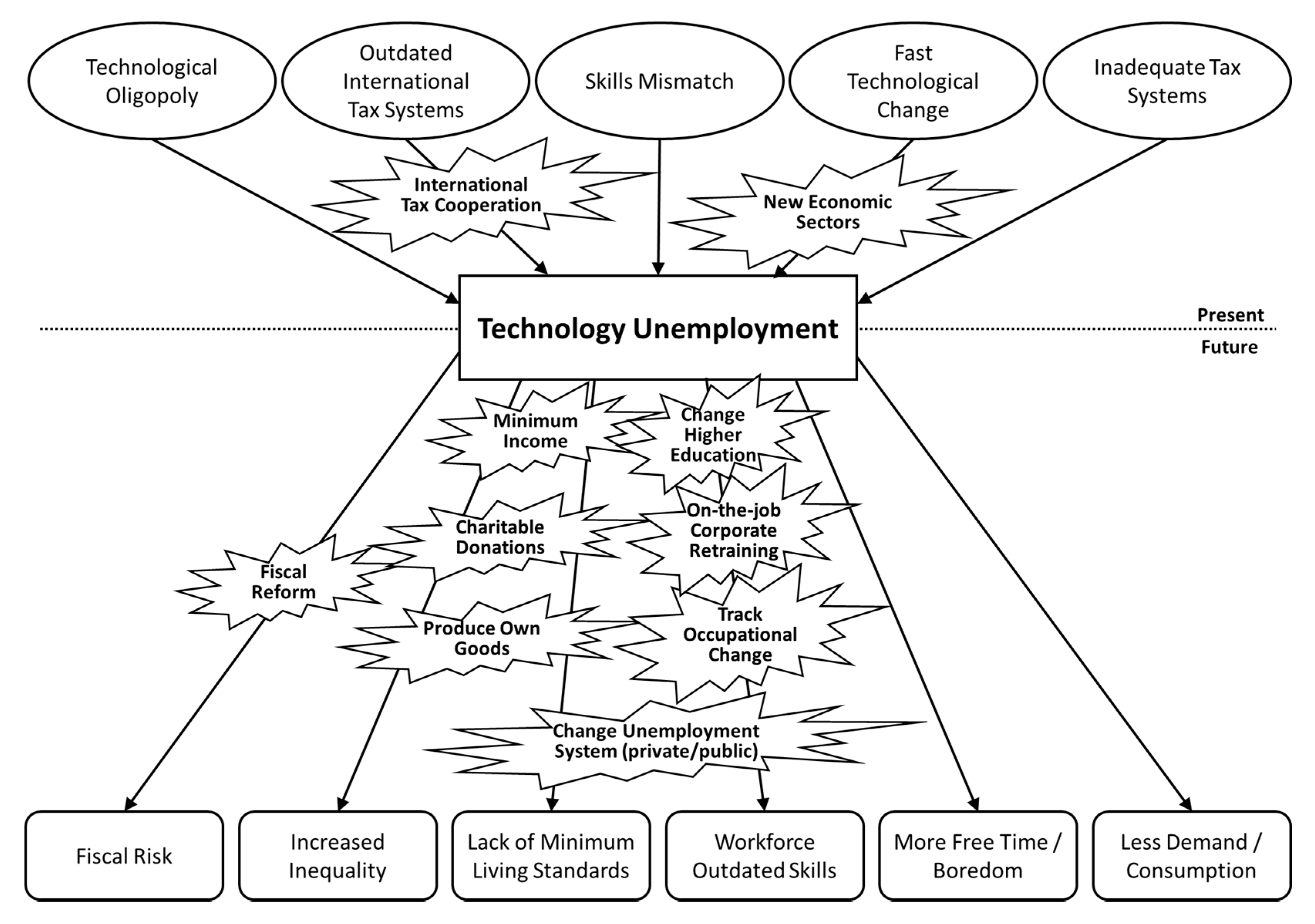Understanding Technological Unemployment: A Review of Causes, Consequences, and Solutions
Abstract
:1. Introduction
- RQ 1. What are the causes of technological unemployment?
- RQ 2. What are the consequences of technological unemployment?
- RQ 3. Which solutions to technological unemployment are being proposed?
- RQ 4. What is the research agenda for technological unemployment?
2. Materials and Methods
3. Results
- Causes: what factors cause or accelerate technological unemployment?
- Consequences: what are the consequences caused by technological unemployment?
- Solutions: what are the actions that could mitigate either the causes or the negative consequences of technological unemployment?
- Research agenda: which opportunities for future research are indicated by the authors?
- Technological Oligopoly: USA and China lead the technology development that will provoke worldwide labor displacement in the near future [28]. Companies such as Amazon, Apple, Facebook, Google, IBM, and Microsoft (in the US) and Alibaba, Baidu, and Tencent (in China) invest heavily in AI technology [29]. These profit-maximizing practices bring economic benefits to the US and China [31] but ignore that developing countries have to deal with its negative consequences, such as technological unemployment [28];
- Outdated International Tax Systems: The international tax system is slow to solve problems related to the digitalized world, especially inequalities between economically developing and developed countries [28];
- Skills Mismatch: Digital technologies are changing faster than organizations and workers’ skills can keep pace [35]. Automation is eroding the demand for human skills in the middle range while increasing skill demand for high and low skills [32]. Finally, if the technology change becomes exponential, workers might be unable to retrain their skills fast enough [3];
- Inadequate Tax Systems: The current tax system charges labor more than capital, stimulating automation since considerably less tax is collected per amount produced by automated processes [36]. The tax system can be used to invert such stimulus by charging more for automated production or providing tax exemptions for “humanized” production [4].
- Increased Inequality: Technological unemployment may increase new forms of inequalities, such as the skill-based divide, due to different levels of professional skills, and the digital divide, due to the lack of access to digital devices and the internet, especially in Africa and Latin America [28]. The skill-based divide can contribute to even higher wage inequality between untrained and highly qualified employees [36];
- More Free Time/Boredom: If our society becomes a leisure society, we face the risk of people being bored, demotivated, and undecided about what to accomplish [38]. Nevertheless, we could use this free time to develop better education and health care and produce personal projects, research, philosophy, and the arts [31];
- Less Demand/Consumption: A large-scale technological unemployment may distort the relationship between offer and demand. If many workers lose their jobs at the same time, the effective demand for new products will shrink [31]. This massive loss of purchasing power has the potential to collapse the economy [41].
- As regards solutions to technological unemployment, we can highlight the following:
- International Tax Cooperation: An international tax cooperation may be used to cope with technological unemployment. Its goal should be to slow down the adoption of new production methods and to finance a global UBI [28];
- New Economic Sectors: Sectors such as tourism and health care rely strongly on human interaction and may see a surge in the future as their jobs are unlikely to be automated soon [2];
- Fiscal Reform: A wide reform of the tax policy is needed, including personal and corporate taxation, since personal taxation does not reach wealthy people as it could [28]. Stronger international taxation rules, negotiated through international agreements can mitigate economic effects between the more and less-developed worlds [28]. Companies should pay taxes when they replace workers with robots [36], and staff education and retraining should produce tax incentives [28];
- Charitable Donations: Wealthy people usually donate a certain proportion of their wealth. If this trend persists, they will be increasing richer and such donations may become help mitigating the negative consequences of technological unemployment [30];
- Produce Own Goods: People might have the alternative to produce their own essential goods. It may take the form of communal farming, building, and teaching, or they may build their own AI or robot that will accomplish some of the work for them [30];
- Change Higher Education: Technological unemployment shows that higher education institutions have to change to be capable of retraining workers quickly to meet the rapidly changing needs of the workplace [2]. Thus, these institutions must offer certificates and degrees faster and more efficiently since more adults with dependents require public support during their training for a different occupation [2], which may be funded by a tax on labor-modifying technological applications [2];
- On-the-Job Corporate Retraining: On-the-job corporate retraining may be considered as worker training programs on steroids: the company teaches tailored skills to their workforce while they work. The high costs associated with the training may cause significant changes in the employer/employee contract, including temporary wage deductions or limited noncompete contract clauses if the employee leaves the firm before a specified period [2];
- Track Occupational Change: The systematic tracking of occupational change may reduce the unpredictability of the labor market, providing a faster response from the government. Such systems must use occupational statistics data to detect patterns and trends in occupational shifting, collect skill demands from sites such as LinkedIn, and tracking the hiring trends; finally, they should survey firms to collect their desired hiring skills [2];
- Change Unemployment System (Private/Public): Current unemployment compensation systems are designed to support cyclical unemployment. However, technological unemployment represents structural unemployment that can be permanent and usually requires retraining for a new occupation. Therefore, the unemployment compensation system should provide retraining aid and monthly checks to support the workers and their families during the retraining period [2]. Private unemployment insurance and personal income savings in preparation for technological unemployment may also play an important role [30].
3.1. Causes
3.2. Consequences
3.3. Solutions
3.3.1. Solutions to Causes
3.3.2. Solutions to Consequences
3.4. Research Agenda
4. Discussion
5. Conclusions
Author Contributions
Funding
Institutional Review Board Statement
Informed Consent Statement
Data Availability Statement
Conflicts of Interest
References
- Campa, R. Three Scenarios of the Future of Work: Technological Unemployment, Compensation, Hollowing Out. Sociol. Y Tecnociencia 2019, 9, 140–154. [Google Scholar] [CrossRef]
- Walden, M.L. Occupation Change and Technological Unemployment in North Carolina. J. Reg. Anal. Policy 2018, 48, 12–22. [Google Scholar]
- Danaher, J. Will Life Be Worth Living in a World Without Work? Technological Unemployment and the Meaning of Life. Sci. Eng. Ethics 2017, 23, 41–64. [Google Scholar] [CrossRef] [PubMed] [Green Version]
- Kim, T.W.; Scheller-Wolf, A. Technological Unemployment, Meaning in Life, Purpose of Business, and the Future of Stakeholders. J. Bus. Ethics 2019, 160, 319–337. [Google Scholar] [CrossRef]
- Frey, C.B.; Osborne, M.A. The Future of Employment: How Susceptible Are Jobs to Computerisation? Technol. Forecast. Soc. Chang. 2017, 114, 254–280. [Google Scholar] [CrossRef]
- Bonin, H.; Gregory, T.; Zierahn, U. Übertragung Der Studie von Frey/Osborne (2013) Auf Deutschland; ZEW Kurzexpertise: Mannheim, Germany, 2015. [Google Scholar]
- Lamb, C.P.; Doyle, S. The Talented Mr. Robot: The Impact of Automation on Canada’s Workforce; Brookfield Institute for Innovation+ Entrepreneurship: Toronto, ON, Canada, 2016. [Google Scholar]
- Brandes, D.; Zobrist, L. Man and Machine: Robots on the Rise; Deloitte: Zurich, Switzerland, 2015. [Google Scholar]
- Frey, C.B.; Osborne, M.A. Agiletown: The Relentless March of Technology and London’s Response; Deloitte: London, UK, 2014. [Google Scholar]
- Krings, B.-J.; Moniz, A.B.; Frey, P. Technology as Enabler of the Automation of Work? Current Societal Challenges for a Future Perspective of Work/A Tecnologia Como Facilitadora Da Automação Do Trabalho? Desafios Sociais Atuais Para Uma Visão Do Futuro Do Trabalho. Rev. Bras. Sociol.-RBS 2021, 9, 206–229. [Google Scholar]
- Lima, Y.; Strauch, J.C.M.; Esteves, M.G.P.; de Souza, J.M.; Chaves, M.B.; Gomes, D.T. Exploring the Future Impact of Automation in Brazil. Empl. Relat. Int. J. 2021. ahead-of-print. [Google Scholar] [CrossRef]
- Santos, I.; Monroy, S.; Moreno, M. Technological Change and Labor Market Disruptions: Evidence from the Developing World. In Proceedings of the 10th IZA Conference Mimeo, Bonn, Germany, 4–5 June 2015; Institute of Labor Economics: Bonn, Germany, 2015. [Google Scholar]
- World Bank Group. World Development Report 2016: Digital Dividends; World Bank Publications: Washington DC, USA, 2016. [Google Scholar]
- Arntz, M.; Gregory, T.; Zierahn, U. The Risk of Automation for Jobs in OECD Countries: A Comparative Analysis; OECD Publishing: Geneva, Switzerland, 2016. [Google Scholar]
- Nedelkoska, L.; Quintini, G. Automation, skills use and training, OECD Social, Employment and Migration Working Papers, No. 202; OECD Publishing: France, Paris, 2018. [Google Scholar]
- The Economist Intelligence Unit. The Automation Readiness Index 2018; The Economist: London, UK, 2018. [Google Scholar]
- Blit, J. Automation and Reallocation: Will COVID-19 Usher in the Future of Work? Can. Public Policy 2020, 46, S192–S202. [Google Scholar] [CrossRef]
- Chernoff, A.W.; Warman, C. COVID-19 and Implications for Automation; National Bureau of Economic Research: Washington, DC, USA, 2020. [Google Scholar]
- Ding, L.; Molina, J.S. Forced Automation” by COVID-19? Early Trends from Current Population Survey Data; Federal Reserve Bank of Philadelphia: Philadelphia, PA, USA, 2020. [Google Scholar]
- Lund, S.; Cheng, W.-L.; Dua, A.; Smet, A.D.; Robinson, O.; Sanghvi, S. What 800 Executives Envision for the Postpandemic Workforce; McKinsey Global Institute: New York, NY, USA, 2020; p. 7. [Google Scholar]
- Zahidi, S.; Ratcheva, V.; Hingel, G.; Brown, S. The Future of Jobs Report 2020; World Economic Forum: Geneva, Switzerland, 2020. [Google Scholar]
- SHRM’s Executive Network; HR People + Strategy; Willis Towers Watson. The Future Chief People Officer: Imagine. Invent. Ignite.; Willis Towers Watson: London, UK, 2020. [Google Scholar]
- Keynes, J. Essays in Persuasion; Springer: Berlin/Heidelberg, Germany, 2016. [Google Scholar]
- Autor, D.H. Why Are There Still so Many Jobs? The History and Future of Workplace Automation. J. Econ. Perspect. 2015, 29, 3–30. [Google Scholar] [CrossRef] [Green Version]
- Strawn, G. Automation and Future Unemployment. IT Prof. 2016, 18, 62–64. [Google Scholar] [CrossRef]
- Kral, P.; Janoskova, K.; Podhorska, I.; Pera, A.; Neguriță, O. The Automatability of Male and Female Jobs: Technological Unemployment, Skill Shift, and Precarious Work. J. Res. Gend. Stud. 2019, 9, 146–152. [Google Scholar] [CrossRef] [Green Version]
- Peters, M.A.; Jandrić, P.; Hayes, S. The Curious Promise of Educationalising Technological Unemployment: What Can Places of Learning Really Do about the Future of Work? Educ. Philos. Theory 2019, 51, 242–254. [Google Scholar] [CrossRef]
- Berberov, A.B.; Milogolov, N.S. Adjusting Tax Policy to the Challenges of Digitalization, Inequality and Technological Unemployment. J. Sib. Fed. Univ.-Humanit. Soc. Sci. 2020, 13, 1710–1722. [Google Scholar] [CrossRef]
- Peters, M.A. Beyond Technological Unemployment: The Future of Work. Educ. Philos. Theory 2020, 52, 485–491. [Google Scholar] [CrossRef]
- Chomanski, B. Massive Technological Unemployment Without Redistribution: A Case for Cautious Optimism. Sci. Eng. Ethics 2019, 25, 1389–1407. [Google Scholar] [CrossRef] [PubMed]
- Naastepad, C.W.M.; Budd, C.H. Preventing Technological Unemployment by Widening Our Understanding of Capital and Progress: Making Robots Work for Us. Ethics Soc. Welf. 2019, 13, 115–132. [Google Scholar] [CrossRef]
- Loi, M. Technological Unemployment and Human Disenhancement. Ethics Inf. Technol. 2015, 17, 201–210. [Google Scholar] [CrossRef]
- Aguilera, A.; Ramos Barrera, M.G. Technological Unemployment: An Approximation to the Latin American Case. Ad-Minist. 2016, 29, 59–78. [Google Scholar] [CrossRef] [Green Version]
- Marx, K. Capital: A Critique of Political Economy, 3 Vols; Penguin Books: London, UK, 1976. [Google Scholar]
- Sedai, A.K. History of Anxiety and Possibility Revisiting Keynes’s Technological Unemployment. Econ. Political Wkly. 2019, 54, 21–23. [Google Scholar]
- Ionescu, L. Should Governments Tax Companies’ Use of Robots? Automated Workers, Technological Unemployment, and Wage Inequality. Econ. Manag. Financ. Mark. 2019, 14, 64–69. [Google Scholar] [CrossRef]
- Harari, Y.N. Homo Deus: A Brief History of Tomorrow; Random House: New York, NY, USA, 2016. [Google Scholar]
- Floridi, L. Technological Unemployment, Leisure Occupation, and the Human Project. Philos. Technol. 2014, 27, 143–150. [Google Scholar] [CrossRef] [Green Version]
- Walsh, T. Expert and Non-Expert Opinion About Technological Unemployment. Int. J. Autom. Comput. 2018, 15, 637–642. [Google Scholar] [CrossRef] [Green Version]
- Fiorelli, F. Technological Unemployment as Frictional Unemployment: From Luddite to Routine-Biased Technological Change. Kybernetes 2018, 47, 333–342. [Google Scholar] [CrossRef]
- Carvalho, L.; Di Guilmi, C. Technological Unemployment and Income Inequality: A Stock-Flow Consistent Agent-Based Approach. J. Evol. Econ. 2020, 30, 39–73. [Google Scholar] [CrossRef]
- Focacci, C.N. Technological Unemployment, Robotisation, and Green Deal: A Story of Unstable Spillovers in China and South Korea (2008–2018). Technol. Soc. 2021, 64, 101504. [Google Scholar] [CrossRef]
- Fernández-De-Córdoba, G.; Moreno-García, E. Union Games: Technological Unemployment. Econ. Theory 2006, 27, 359–373. [Google Scholar] [CrossRef]
- Kim, Y.J.; Kim, K.; Lee, S. The Rise of Technological Unemployment and Its Implications on the Future Macroeconomic Landscape. Futures 2017, 87, 1–9. [Google Scholar] [CrossRef]
- Peters, M.A. Technological Unemployment: Educating for the Fourth Industrial Revolution. Educ. Philos. Theory 2017, 49, 1–6. [Google Scholar] [CrossRef] [Green Version]
- Postel-Vinay, F. The Dynamics of Technological Unemployment. Int. Econ. Rev. 2002, 43, 737–760. [Google Scholar] [CrossRef]
- Feldmann, H. Technological Unemployment in Industrial Countries. J. Evol. Econ. 2013, 23, 1099–1126. [Google Scholar] [CrossRef]
- Kapeliushnikov, R. The Phantom of Technological Unemployment. Russ. J. Econ. 2019, 5, 88–116. [Google Scholar] [CrossRef]
- Charette, R.N. Technological Unemployment: An Absurd Worry or Valid Concern? Cut. IT J. 2015, 28, 6–11. [Google Scholar]
- Acemoglu, D.; Autor, D. Skills, tasks and technologies: Implications for employment and earnings. In Handbook of Labor Economics; Elsevier: Amsterdam, The Netherlands, 2011; Volume 4, pp. 1043–1171. [Google Scholar]
- Comin, D.; Hobijn, B. An Exploration of Technology Diffusion. Am. Econ. Rev. 2010, 100, 2031–2059. [Google Scholar] [CrossRef] [Green Version]
- Keynes, J.M. A Tract on Monetary Reform; Macmillan: London, UK, 1923. [Google Scholar]
- De Masi, D.; Palieri, M.S. O Ócio Criativo; Sextante: Rio de Janeiro, Brazil, 2000. [Google Scholar]
- Sabetta, L. Self-Defeating Prophecies: When Sociology Really Matters. In Anticipation, Agency and Complexity; Poli, R., Valerio, M., Eds.; Anticipation Science; Springer International Publishing: Cham, Switzerland, 2019; pp. 51–59. ISBN 978-3-030-03623-2. [Google Scholar]
- Huxley, A. Brave New World (1932); Vintage: London, UK, 1998. [Google Scholar]
- Voltaire, F. Candide, or Optimism; Penguin: London, UK, 2013. [Google Scholar]




| Source Title | # of Papers |
|---|---|
| Educational Philosophy and Theory | 3 |
| Journal of Evolutionary Economics | 2 |
| Science and Engineering Ethics | 2 |
| Ad-Minister | 1 |
| Cutter IT Journal | 1 |
| Economic and Political Weekly | 1 |
| Economic Theory | 1 |
| Economics, Management, and Financial Markets | 1 |
| Ethics and Information Technology | 1 |
| Ethics and Social Welfare | 1 |
| Futures | 1 |
| International Economic Review | 1 |
| International Journal of Automation and Computing | 1 |
| Journal of Business Ethics | 1 |
| Journal of Regional Analysis and Policy | 1 |
| Journal of Research in Gender Studies | 1 |
| Journal of Siberian Federal University—Humanities and Social Sciences | 1 |
| Kybernetes | 1 |
| Philosophy and Technology | 1 |
| Russian Journal of Economics | 1 |
| Social Research | 1 |
| Sociología y Tecnociencia | 1 |
| Technology in Society | 1 |
| Subject Area | # of Papers |
|---|---|
| Economic | 14 |
| Social | 7 |
| Philosophy/Ethics | 6 |
Publisher’s Note: MDPI stays neutral with regard to jurisdictional claims in published maps and institutional affiliations. |
© 2021 by the authors. Licensee MDPI, Basel, Switzerland. This article is an open access article distributed under the terms and conditions of the Creative Commons Attribution (CC BY) license (https://creativecommons.org/licenses/by/4.0/).
Share and Cite
Lima, Y.; Barbosa, C.E.; dos Santos, H.S.; de Souza, J.M. Understanding Technological Unemployment: A Review of Causes, Consequences, and Solutions. Societies 2021, 11, 50. https://0-doi-org.brum.beds.ac.uk/10.3390/soc11020050
Lima Y, Barbosa CE, dos Santos HS, de Souza JM. Understanding Technological Unemployment: A Review of Causes, Consequences, and Solutions. Societies. 2021; 11(2):50. https://0-doi-org.brum.beds.ac.uk/10.3390/soc11020050
Chicago/Turabian StyleLima, Yuri, Carlos Eduardo Barbosa, Herbert Salazar dos Santos, and Jano Moreira de Souza. 2021. "Understanding Technological Unemployment: A Review of Causes, Consequences, and Solutions" Societies 11, no. 2: 50. https://0-doi-org.brum.beds.ac.uk/10.3390/soc11020050







